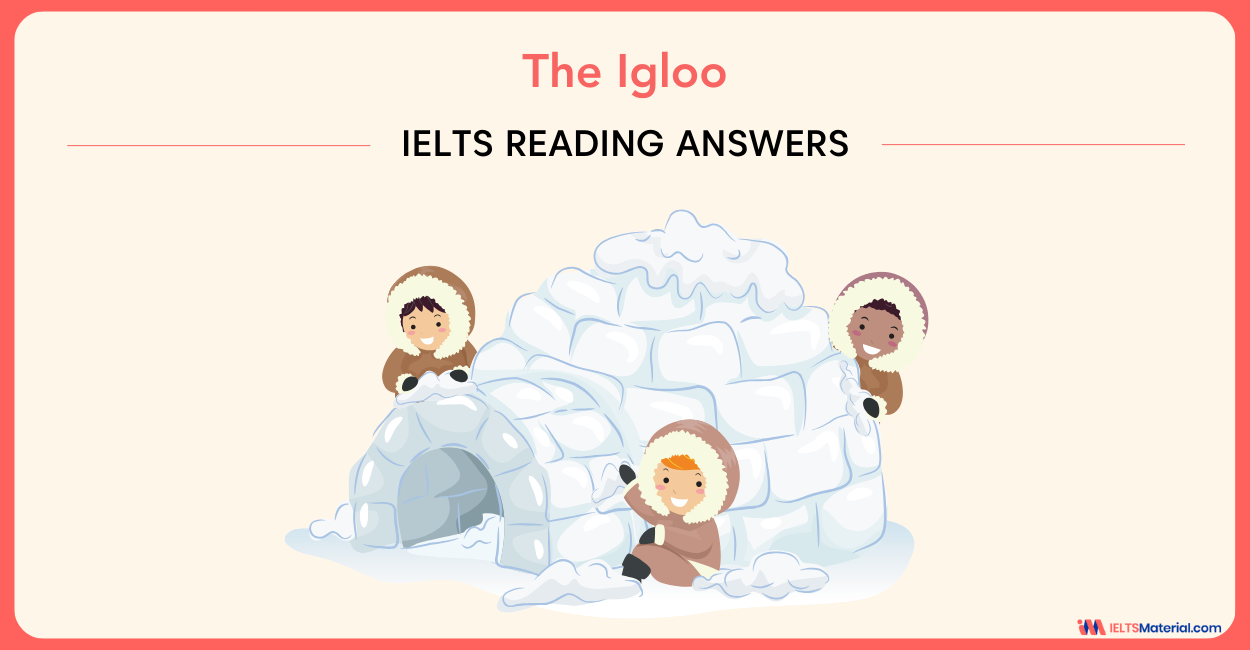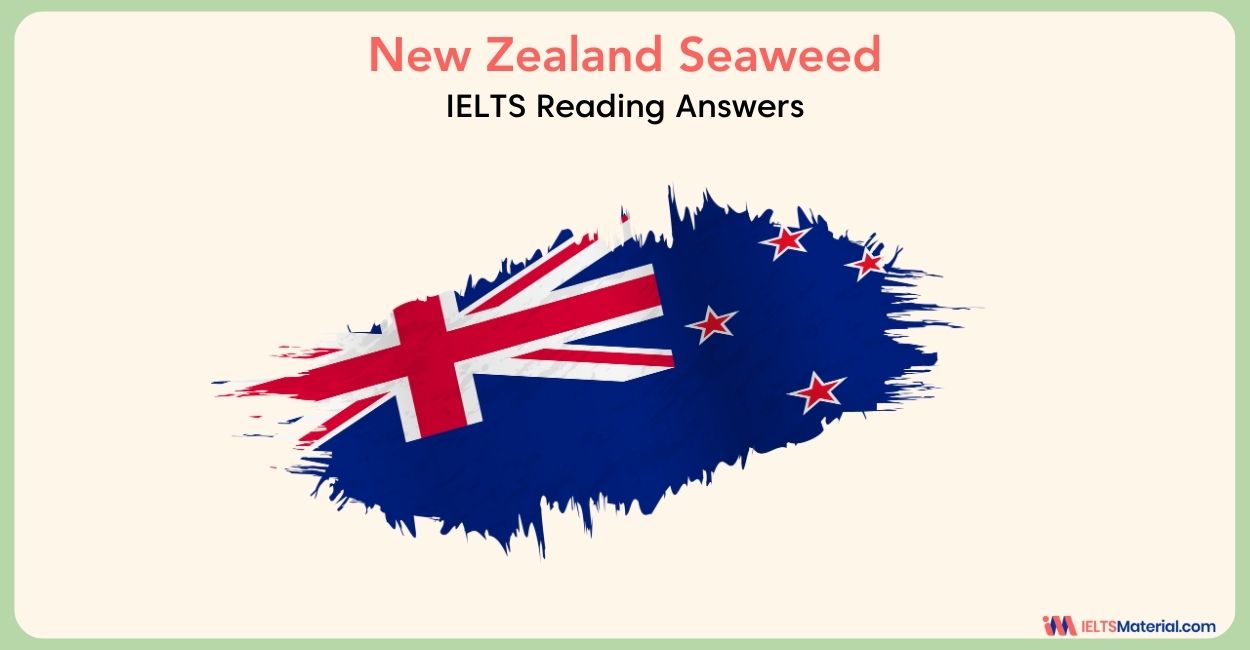New Zealand Seaweed - IELTS Reading Answers
6 min read
Updated On
-
Copy link
You will find IELTS Academic Reading passage, New Zealand Seaweed Reading Answers, in this article. Practise this one and you will get an idea of how to deal with IELTS Reading.
Table of Contents

Limited-Time Offer : Access a FREE 10-Day IELTS Study Plan!
New Zealand Seaweed is a real Reading test passage that appeared in the IELTS Academic exam. With diligent practice, the Reading Module can be the top-scoring category for IELTS aspirants. To score well, you must learn how to scan the given text, highlight keywords using the IELTS Reading keyword techniques and locate the answer within the limited duration of the exam in order to achieve the desired band score in the IELTS Reading exam.
By solving and reviewing Sample Reading Questions from past IELTS papers, you can ensure that your Reading skills are up to the mark. Take the practice test, New Zealand Seaweed, below and try more IELTS reading practice tests from IELTSMaterial.com.
The question types found in this passage are:
Not sure how to answer IELTS Reading Flow Chart questions? Check out the video below for the latest tips and strategies!
New Zealand Seaweed
You should spend about 20 minutes on Questions 1-13, which are based on the Reading Passage below. Find the practice test with the New Zealand Seaweed PDF here.
Answers for New Zealand Seaweed Reading Passage with Location and Explanations
Check out the answer key for this IELTS Academic Reading passage, New Zealand Seaweed, with detailed explanations for each of them.
1 Answer: v
Question Type: Matching Headings
Answer location: Section A, line 1
Answer explanation: Section A puts forward the information that “seaweed is a particularly nutritious food, which absorbs and concentrates traces of a wide variety of minerals necessary to the body’s health” Here, we can observe that seaweed is a valuable food in terms of nutrition.
2 Answer: ii
Question Type: Matching Headings
Answer location: Section B, line 5
Answer explanation: If you read thoroughly, there is a line that claims “the gel-forming substance called agar which can be extracted from this species gives them great commercial application in seameal, from which seameal custard is made, and in cough mixture, confectionery, cosmetics, the canning, paint and leather industries, the manufacture of duplicating pads, and in toothpaste.” From this given information we can infer that seaweed is used in a variety of products, such as cough mixture, confectionery, cosmetics, the canning, paint, and leather industries, the manufacture of duplicating pads, and in toothpaste, etc.
3 Answer: viii
Question Type: Matching Headings
Answer location: Section C, lines 2-3
Answer explanation: The answer is clearly mentioned in the said paragraph and line. You must note the paraphrasing here. In the passage, it is said that “yet although New Zealand has so much of the commercially profitable red seaweeds, several of which are a source of agar (Pterocladia, Gelidium, Chondrus, Gigartina), before 1940 relatively little use was made of them.” Here, it is given that despite the fact that seaweeds help boost New Zealand economically, before 1940 there were some agar species that were not used a lot.
4 Answer: i
Question Type: Matching Headings
Answer location: Section D, line 1
Answer explanation: In the said paragraph, you can refer to, “seaweeds are divided into three classes determined by colour – red, brown and green – and each tends to live in a specific location.” From this information, we can infer that the passage discusses the special features of seaweeds, which are categorized according to colour, and each category with a specific colour often is found in a certain place (location).
5 Answer: x
Question Type: Matching Headings
Answer location: Section E, line 1
Answer explanation: In the said paragraph, you can refer to, “propagation of seaweeds occurs by spores, or by fertilisation of egg cells.” Thus, seaweeds reproduce and develop using two methods: spores and fertilisation of egg cells.
6 Answer: vi
Question Type: Matching Headings
Answer location: Section F, line 1
Answer explanation: You can note the paraphrasing here. In the passage, it states that “some of the large seaweeds maintain buoyancy with air-filled floats; others, such as bull kelp, have large cells filled with air.” Here, the author mentions a seaweed feature that prevents them from sinking.
7 Answer: New Zealand Carrageen
Question Type: Flow Chart Completion
Answer location: Section B, line 3
Answer explanation: A line in the said paragraph infers that “for example, it is estimated that New Zealand has some 30 species of Gigartina, a close relative of carrageen or Irish moss. These are often referred to as the New Zealand carrageens.” Since it is provided that Gigartina is often referred to as New Zealand carrageens, we can infer that Gigartina is also called New Zealand carrageens.
8 Answer: agar
Question Type: Flow Chart Completion
Answer location: Section B, line 4
Answer explanation: If you read thoroughly, there’s a line in the said paragraph that describes “the gel-forming substance called agar which can be extracted from this species gives them great commercial application in seameal, from which seameal custard is made, and in cough mixture, confectionery, cosmetics, the canning, paint and leather industries, the manufacture of duplicating pads, and in toothpaste.” Here, the author states that agar is extracted from Newzealand Carrageens. Hence, we can conclude that New Zealand carrageens are made into agar.
9 Answer: seameal
Question Type: Flow Chart Completion
Answer location: Section B, line 4
Answer explanation: A line in the said paragraph indicates “the gel-forming substance called agar which can be extracted from this species gives them great commercial application in seameal, from which seameal custard is made, and in cough mixture, confectionery, cosmetics, the canning, paint and leather industries, the manufacture of duplicating pads, and in toothpaste” Here, we can locate the information that food refers to seameal custard, confectionary, and canning in the passage.
10 Answer: Cough mixture
Question Type: Flow Chart Completion
Answer location: Section B, line 4
Answer explanation: Section B also provides the information that “the gel-forming substance called agar which can be extracted from this species gives them great commercial application in seameal, from which seameal custard is made, and in cough mixture, confectionery, cosmetics, the canning, paint and leather industries, the manufacture of duplicating pads, and in toothpaste” In the given statement out of all these products, only “cough mixture” relates to medicine.
11 Answer: A
Question Type: Matching features
Answer location: Section D, line 4
Answer explanation: If you read thoroughly, the author in the given paragraph mentions that “Although there are exceptions, the green seaweeds are mainly shallow-water algae; the browns belong to medium depths, and the reds are plants of the deeper water.” Also, “those species able to resist long periods of exposure to the sun and air are usually found on the upper shore, while those less able to stand such exposure occur nearer to or below the low-water mark. Radiation from the sun, the temperature level, and the length of time immersed all play a part in the zoning of seaweeds.” Since green seaweeds are a variety of algae growing on the sea bed in shallow waters, it implies green seaweeds can resist exposure to sunlight at the high-water marks.
12 Answer: C
Question Type: Matching features
Answer location: Section D, line 4
Answer explanation: In the said paragraph, refer that, “Although there are exceptions, the green seaweeds are mainly shallow-water algae; the browns belong to medium depths, and the reds are plants of the deeper water.” “deep-water rocks on open coasts, exposed only at very low tide, are usually the site of bull kelp, strap weeds, and similar tough specimens.” Here, it is given that reds are plants of the deeper water, which implies red seaweeds grown in far open seawater where water is deep.
13 Answer: B
Question Type: Matching features
Answer location: Section D, line 5
Answer explanation: Paragraph D puts forward the information that “flat rock surfaces near mid-level tides are the most usual habitat of sea bombs, Venus’ necklace, and most brown seaweeds. This is also the location of the purple laver or Maori karengo, which looks rather like reddish-purple lettuce.” Mid-level tides are the habitats of brown seaweeds, and it is the same location where Maori Karengo lives. Hence, brown seaweeds share their habitat with karengo.
Also check:
- Grimm’s Fairy Tales Reading Answers
- Children’s Literature IELTS Reading Answers
- How to Prepare IELTS at Home?
- Citywide Power Company- IELTS Reading Answers
- Storytelling – IELTS Reading Answers
- Time Management for IELTS Reading
- 20 Best IELTS Preparation Books for Self Study
- Roman shipbuilding and Navigation IELTS Reading Answers
- Could Urban Engineers Learn From Dance?
Practice IELTS Reading based on question types

Start Preparing for IELTS: Get Your 10-Day Study Plan Today!
Explore other Reading Topics

Kasturika Samanta

Kasturika Samanta

Kasturika Samanta
Recent Articles

Nehasri Ravishenbagam

Haniya Yashfeen

Haniya Yashfeen

Haniya Yashfeen





Post your Comments